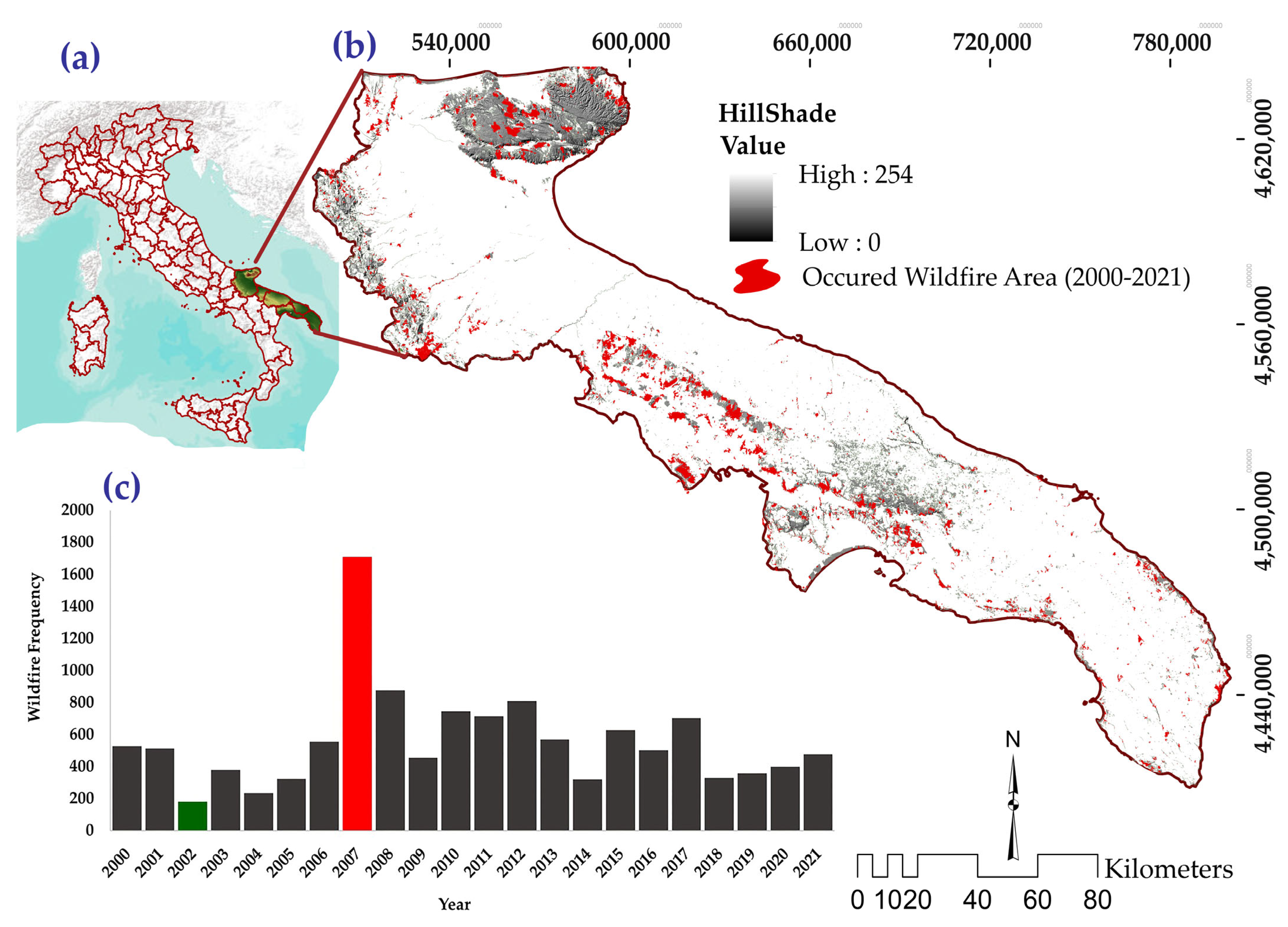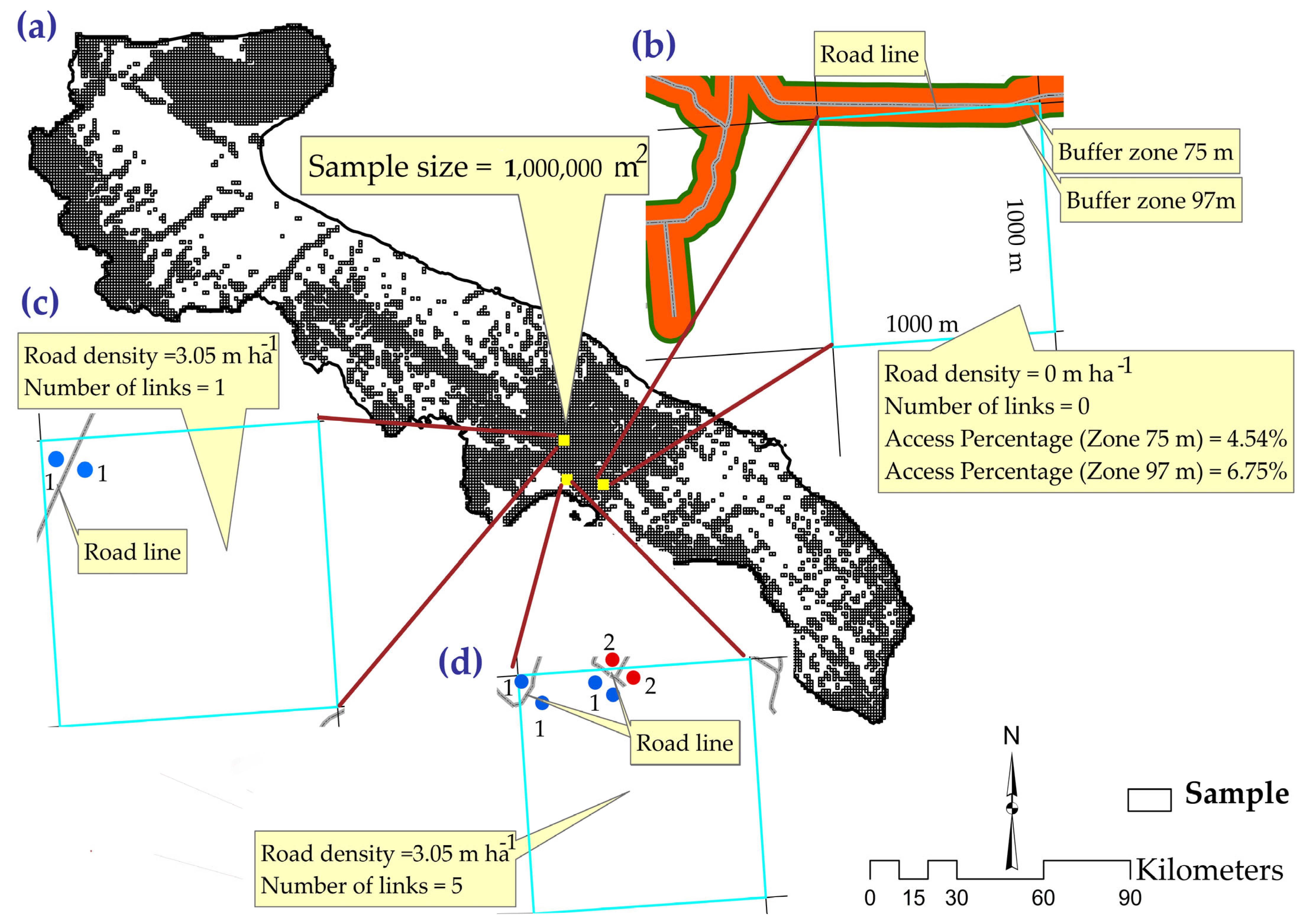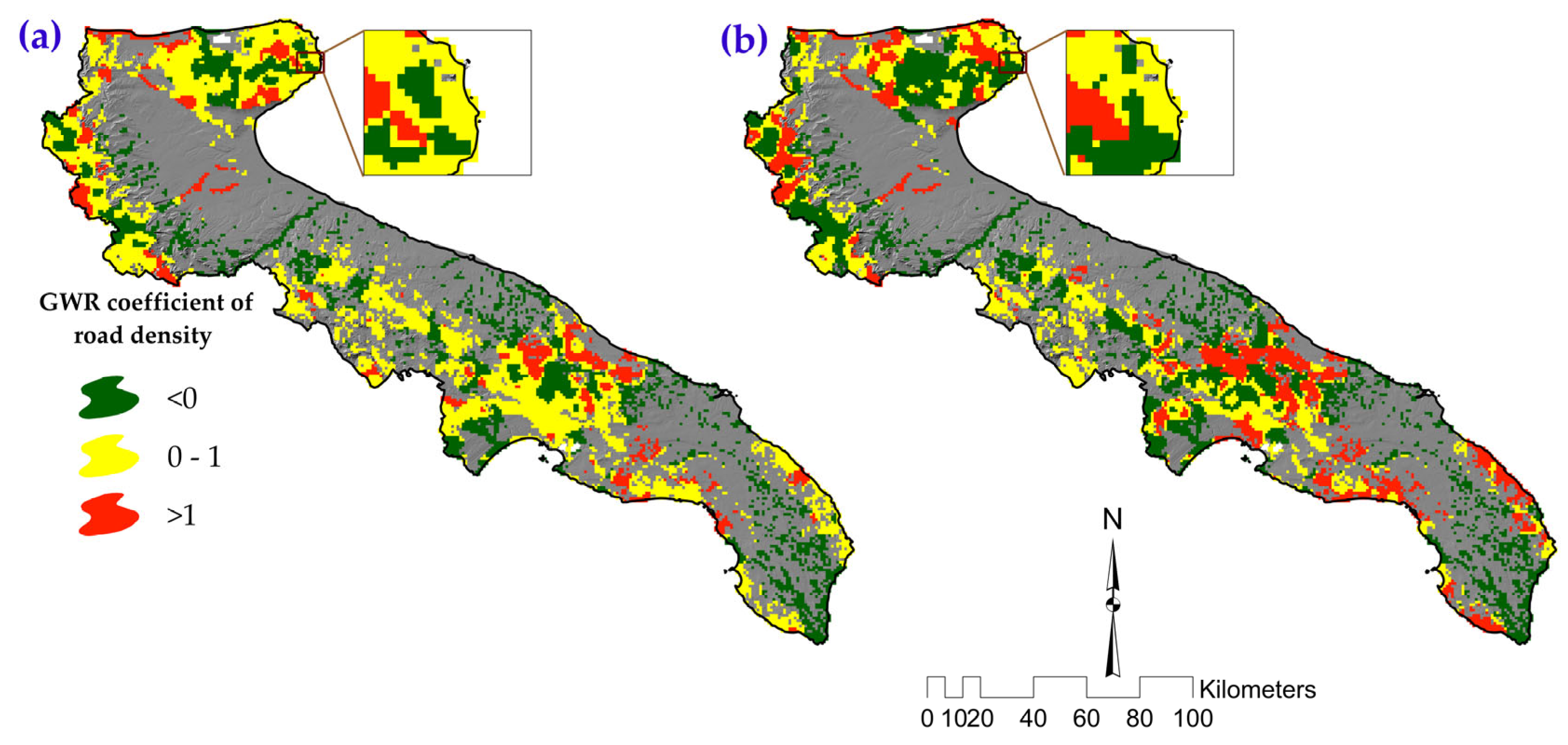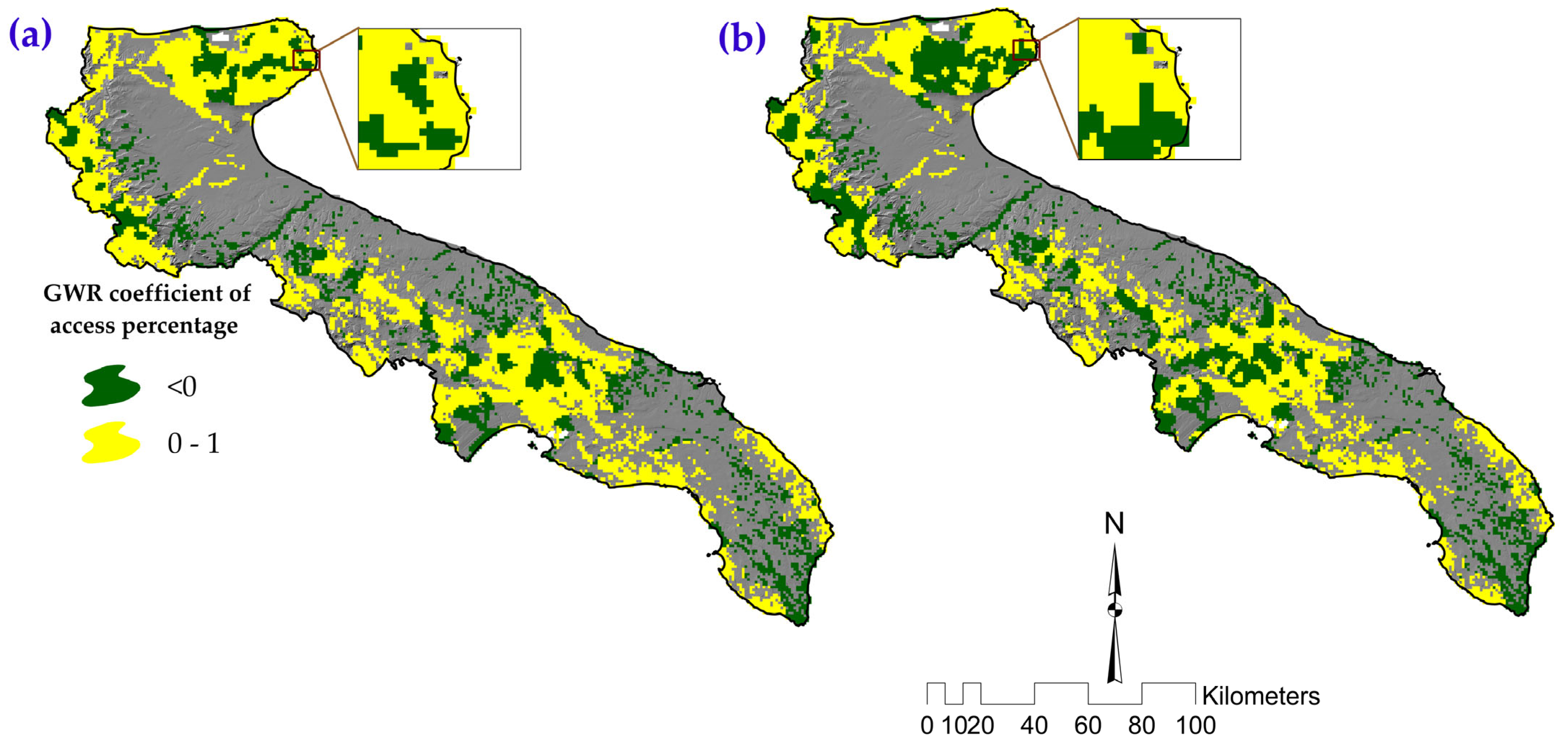Assessing Forest Road Network Suitability in Relation to the Spatial Occurrence of Wildfires in Mediterranean Forest Ecosystems
Abstract
1. Introduction
2. Materials and Methods
2.1. Study Area
2.2. Datasets
2.2.1. Response Variables
2.2.2. Explanatory Factors
- Historical wildfires
- Land cover
- Geomorphological data
- Normalized Difference Vegetation Index (NDVI)
- Topographic Position Index (TPI)
- Topographic Roughness Index (TRI)
- Topographic Wetness Index (TWI)
2.3. Data Processing
- Ordinary least squares
- Geographically weighted regression
3. Results
3.1. Variables in Detail
3.2. Correlation Assessment
3.3. GWR and OLS Results of Road Density
3.4. Spatial Variations in the Response of the Road Density Metric to Explanatory Variables
3.5. GWR and OLS Results for Number of Links
3.6. Spatial Variations in the Response of the “Number of Links” Metric to Explanatory Variables
3.7. GWR and OLS Results of Access Percentage
3.8. Spatial Variations in the Response of Access Percentage Metric to Explanatory Variables
4. Discussion
5. Conclusions
Supplementary Materials
Author Contributions
Funding
Institutional Review Board Statement
Informed Consent Statement
Data Availability Statement
Acknowledgments
Conflicts of Interest
References
- Parajuli, A.; Gautam, A.P.; Sharma, S.P.; Bhujel, K.B.; Sharma, G.; Thapa, P.B.; Bist, B.S.; Poudel, S. Forest Fire Risk Mapping Using GIS and Remote Sensing in Two Major Landscapes of Nepal. Geomat. Nat. Hazards Risk. 2020, 11, 2569–2586. [Google Scholar] [CrossRef]
- Shmuel, A.; Heifetz, E. A Machine-Learning Approach to Predicting Daily Wildfire Expansion Rate. Fire 2023, 6, 319. [Google Scholar] [CrossRef]
- Thompson, M.P.; Gannon, B.M.; Caggiano, M.D. Forest Roads and Operational Wildfire Response Planning. Forests 2021, 12, 110. [Google Scholar] [CrossRef]
- Elia, M.; Giannico, V.; Lafortezza, R.; Sanesi, G. Modeling Fire Ignition Patterns in Mediterranean Urban Interfaces. Stoch. Environ. Res. Risk Assess. 2019, 33, 169–181. [Google Scholar] [CrossRef]
- D’Este, M.; Ganga, A.; Elia, M.; Lovreglio, R.; Giannico, V.; Spano, G.; Colangelo, G.; Lafortezza, R.; Sanesi, G. Modeling Fire Ignition Probability and Frequency Using Hurdle Models: A Cross-Regional Study in Southern Europe. Ecol. Process. 2020, 9, 54. [Google Scholar] [CrossRef]
- Yang, J.; He, H.S.; Shifley, S.R.; Gustafson, E.J. Spatial Patterns of Modern Period Human-Caused Fire Occurrence in the Missouri Ozark Highlands. For. Sci. 2007, 53, 1–15. [Google Scholar] [CrossRef]
- Niu, C.; Nair, D.J.; Zhang, T.; Dixit, V.; Murray-Tuite, P. Are Wildfire Fatalities Related to Road Network Characteristics? A Preliminary Analysis of Global Wildfire Cases. Int. J. Disaster Risk Reduct. 2022, 80, 103217. [Google Scholar] [CrossRef]
- Dye, A.; Kim, J.; McEvoy, A.; Fang, F.; Riley, K. Evaluating Rural Pacific Northwest Towns for Wildfire Evacuation Vulnerability. Nat. Hazards 2021, 107, 911–935. [Google Scholar] [CrossRef]
- de Araujo, M.P.; Lupa, M.R.; Casper, C.T.; Waters, B. Wildfire Evacuation Scenario in Colorado: Comparison of Adapted Four-Step Metropolitan Planning Organization Modeling Results and Planning Process Findings with Actual Experience. Transp. Res. Rec. 2014, 2430, 133–144. [Google Scholar] [CrossRef]
- Akay, A.E.; Aruga, K.; Bettinger, P.; Sessions, J. Using optimization techniques in designing forest roads and road networks. Bartın Orman. Fakültesi Dergisi 2013, 15, 49–62. [Google Scholar]
- Lafortezza, R.; Sanesi, G.; Chen, J. Large-Scale Effects of Forest Management in Mediterranean Landscapes of Europe. IForest 2013, 6, 342–346. [Google Scholar] [CrossRef]
- Laschi, A.; Neri, F.; Montorselli, N.; Marchi, E. A Methodological Approach Exploiting Modern Techniques for Forest Road Network Planning. Croat. J. For. Eng. 2016, 37, 319–331. [Google Scholar]
- Heinimann, H. Forest Road Network and Transportation Engineering—State and Perspectives. Croat. J. For. Eng. 2017, 38, 155–173. [Google Scholar]
- Akay, A.O.; Akgul, M.; Demir, M.; Acar, H.H. Analysis of Factors Associated with the Amount of Forest Road Reconstruction Activity in Turkey: Autoregressive Distributed Lag Modelling Approach. Ecol. Manag. 2020, 458, 117800. [Google Scholar] [CrossRef]
- Beguš, J.; Pertlik, E. Guide for Planning, Construction and Maintenance of Forest Roads; Food and Agriculture 587 Organization of the United Nations: Rome, Italy, 2017; pp. 304–311. Available online: https://www.fao.org/sustainable-forest-management/toolbox/tools/tool-detail/en/c/1255267/ (accessed on 29 January 2024).
- Mostafa, M.; Shataee, S.; Lotfalian, M.; Sadoddin, A. Watershed Road Network Analysis with an Emphasis on Fire Fighting Management. J. Environ. Eng. Landsc. Manag. 2017, 25, 342–353. [Google Scholar] [CrossRef]
- Hong, H.; Jaafari, A.; Zenner, E.K. Predicting Spatial Patterns of Wildfire Susceptibility in the Huichang County, China: An Integrated Model to Analysis of Landscape Indicators. Ecol. Indic. 2019, 101, 878–891. [Google Scholar] [CrossRef]
- Bergonse, R.; Oliveira, S.; Santos, P.; Zêzere, J. Wildfire Risk Levels at the Local Scale: Assessing the Relative Influence of Hazard, Exposure, and Social Vulnerability. Fire 2022, 5, 166. [Google Scholar] [CrossRef]
- Sinha, A.; Nikhil, S.; Ajin, R.S.; Danumah, J.; Saha, S.; Costache, R.-D.; Ambujendran, R.; Sajinkumar, K.S.; Amrutha, K.; Johny, A.; et al. Wildfire Risk Zone Mapping in Contrasting Climatic Conditions: An Approach Employing AHP and F-AHP Models. Fire 2023, 6, 44. [Google Scholar] [CrossRef]
- Zhang, F.; Bin, Z.; Luo, J.; Liu, H.; Qingchun, D.; Wang, L.; Zuo, Z. Forest Fire Driving Factors and Fire Risk Zoning Based on an Optimal Parameter Logistic Regression Model: A Case Study of the Liangshan Yi Autonomous Prefecture, China. Fire 2023, 6, 336. [Google Scholar] [CrossRef]
- Rodrigue, J.P. The Geography of Transport Systems; Routledg: London, UK, 2020; pp. 320–330. [Google Scholar] [CrossRef]
- Backmund, F. Kennzahlen Für Den Grad Der Erschließung von Forstbetrieben Durch Autofahrbare Wege. Forstwiss. Centralblatt. 1966, 85, 342–354. [Google Scholar] [CrossRef]
- Pentek, T.; Pičman, D.; Potočnik, I.; Dvorščak, P.; Nevečerel, H. Analysis of an Existing Forest Road Network. Croat. J. For. Eng. 2005, 26, 39–50. [Google Scholar]
- Martín, B.; Ortega, E.; Cuevas-Wizner, R.; Ledda, A.; De Montis, A. Assessing Road Network Resilience: An Accessibility Comparative Analysis. Transp. Res. D Transp. Environ. 2021, 95, 102851. [Google Scholar] [CrossRef]
- Travers, E.; Härdtle, W.; Matthies, D. Corridors as a Tool for Linking Habitats—Shortcomings and Perspectives for Plant Conservation. J. Nat. Conserv. 2021, 60, 125974. [Google Scholar] [CrossRef]
- McCoy, K.; Krasko, V.; Santi, P.; Kaffine, D.; Rebennack, S. Minimizing Economic Impacts from Post-Fire Debris Flows in the Western United States. Nat. Hazards 2016, 83, 149–176. [Google Scholar] [CrossRef]
- Ferrari, C.; Santagata, M. Vulnerability and Robustness of Interdependent Transport Networks in North-Western Italy. Eur. Transp. Res. Rev. 2023, 15, 6. [Google Scholar] [CrossRef]
- Freiria, S.; Ribeiro, B.; Tavares, A.O. Understanding Road Network Dynamics: Link-Based Topological Patterns. J. Transp. Geogr. 2015, 46, 55–66. [Google Scholar] [CrossRef]
- Almotahari, A.; Yazici, A. A Computationally Efficient Metric for Identification of Critical Links in Large Transportation Networks. Reliab. Eng. Syst. Saf. 2021, 209, 107458. [Google Scholar] [CrossRef]
- Elia, M.; Lafortezza, R.; Lovreglio, R.; Sanesi, G. Developing Custom Fire Behavior Fuel Models for Mediterranean Wildland–Urban Interfaces in Southern Italy. Environ. Manag. 2015, 56, 754–764. [Google Scholar] [CrossRef] [PubMed]
- Puglia.con. Available online: https://www.sit.puglia.it/ (accessed on 2 February 2024).
- Sugiura, S.; Kurauchi, F. Isolation Vulnerability Analysis in Road Network: Edge Connectivity and Critical Link Sets. Transp. Res. D Transp. Environ. 2023, 119, 103768. [Google Scholar] [CrossRef]
- Hayati, E.; Majnounian, B.; Abdi, E. Qualitative Evaluation and Optimization of Forest Road Network to Minimize Total Costs and Environmental Impacts. IForest 2012, 5, 121–125. [Google Scholar] [CrossRef]
- Różycka, M.; Migoń, P.; Michniewicz, A. Topographic Wetness Index and Terrain Ruggedness Index in Geomorphic Characterisation of Landslide Terrains, on Examples from the Sudetes; SW Poland. 2016. Available online: https://www.schweizerbart.de/papers/zfg_suppl/detail/61/88285/Topographic_Wetness_Index_and_Terrain_Ruggedness_I?af=crossref (accessed on 2 February 2024).
- Fan, B.; Tao, W.; Qin, G.; Hopkins, I.; Zhang, Y.; Wang, Q.; Lin, H.; Guo, L. Soil Micro-Climate Variation in Relation to Slope Aspect, Position, and Curvature in a Forested Catchment. Agric. For. Meteorol. 2020, 290, 107999. [Google Scholar] [CrossRef]
- Pettorelli, N. The Normalized Difference Vegetation Index; Oxford University Press: Oxford, UK, 2013; Volume 194, pp. 11–21. [Google Scholar] [CrossRef]
- De Reu, J.; Bourgeois, J.; Bats, M.; Zwertvaegher, A.; Gelorini, V.; De Smedt, P.; Chu, W.; Antrop, M.; De Maeyer, P.; Finke, P.; et al. Application of the Topographic Position Index to Heterogeneous Landscapes. Geomorphology 2013, 186, 39–49. [Google Scholar] [CrossRef]
- Chowdhury, M.S. Modelling Hydrological Factors from DEM Using GIS. MethodsX 2023, 10, 102062. [Google Scholar] [CrossRef] [PubMed]
- Gorum, T.; Gonencgil, B.; Gokceoglu, C.; Nefeslioglu, H.A. Implementation of Reconstructed Geomorphologic Units in Landslide Susceptibility Mapping: The Melen Gorge (NW Turkey). Nat. Hazards 2008, 46, 323–351. [Google Scholar] [CrossRef]
- Beven, K.J.; Kirkby, M.J. A Physically Based, Variable Contributing Area Model of Basin Hydrology/Un Modèle à Base Physique de Zone d’appel Variable de l’hydrologie Du Bassin Versant. Hydrol. Sci. Bull. 1979, 24, 43–69. [Google Scholar] [CrossRef]
- Jafino, B.A.; Kwakkel, J.; Verbraeck, A. Transport Network Criticality Metrics: A Comparative Analysis and a Guideline for Selection. Transp. Rev. 2020, 40, 241–264. [Google Scholar] [CrossRef]
- Koutsias, N.; Martínez-Fernández, J.; Allgöwer, B. Do Factors Causing Wildfires Vary in Space? Evidence from Geographically Weighted Regression. GIScience Remote Sens. 2010, 47, 221–240. [Google Scholar] [CrossRef]
- Hu, X.; Xu, H. Spatial Variability of Urban Climate in Response to Quantitative Trait of Land Cover Based on GWR Model. Environ. Monit. Assess. 2019, 191, 194. [Google Scholar] [CrossRef] [PubMed]
- Zheng, X.; Zou, Z.; Xu, C.; Lin, S.; Wu, Z.; Qiu, R.; Hu, X.; Li, J. A New Remote Sensing Index for Assessing Spatial Heterogeneity in Urban Ecoenvironmental-Quality-Associated Road Networks. Land 2021, 11, 46. [Google Scholar] [CrossRef]
- Koh, E.H.; Lee, E.; Lee, K.-K. Application of Geographically Weighted Regression Models to Predict Spatial Characteristics of Nitrate Contamination: Implications for an Effective Groundwater Management Strategy. J. Environ. Manag. 2020, 268, 110646. [Google Scholar] [CrossRef] [PubMed]
- Elia, M.; Lafortezza, R.; Cappelluti, O.; Costa-Saura Josè, M.; Bacciu, V.; Giannico, V.; Changliang, S.; Sanesi, G. Coupling Heat Wave and Wildfire Occurrence across Multiple Ecoregions within a Eurasia Longitudinal Gradient. Sci. Total Environ. 2024, 912, 169269. [Google Scholar] [CrossRef] [PubMed]
- Latham, M.; Cumming, S.; Krawchuk, M.; Boutin, S. Road Network Density Correlated with Increased Lightning Fire Incidence in the Canadian Western Boreal Forest. Int. J. Wildland Fire 2009, 18, 970–982. [Google Scholar] [CrossRef]
- Narayanaraj, G.; Wimberly, M.C. Influences of Forest Roads on the Spatial Patterns of Human- and Lightning-Caused Wildfire Ignitions. Appl. Geogr. 2012, 32, 878–888. [Google Scholar] [CrossRef]
- Rezaie, F.; Panahi, M.; Bateni, S.M.; Lee, S.; Jun, C.; Trauernicht, C.; Neale, C.M.U. Development of Novel Optimized Deep Learning Algorithms for Wildfire Modeling: A Case Study of Maui, Hawai‘i. Eng. Appl. Artif. Intell. 2023, 125, 106699. [Google Scholar] [CrossRef]
- Zambon, I.; Cerdà, A.; Cudlín, P.; Serra, P.; Pili, S.; Salvati, L. Road Network and the Spatial Distribution of Wildfires in the Valencian Community (1993–2015). Agriculture 2019, 9, 100. [Google Scholar] [CrossRef]
- Syphard, A.D.; Radeloff, V.C.; Keuler, N.S.; Taylor, R.S.; Hawbaker, T.J.; Stewart, S.I.; Clayton, M.K. Predicting Spatial Patterns of Fire on a Southern California Landscape. Int. J. Wildland Fire 2008, 17, 602–613. [Google Scholar] [CrossRef]
- Maingi, J.K.; Henry, M.C. Factors Influencing Wildfire Occurrence and Distribution in Eastern Kentucky, USA. Int. J. Wildland Fire 2007, 16, 23–33. [Google Scholar] [CrossRef]
- Kuklina, V.; Sizov, O.; Bogdanov, V.; Krasnoshtanova, N.; Morozova, A.; Petrov, A.N. Combining Community Observations and Remote Sensing to Examine the Effects of Roads on Wildfires in the East Siberian Boreal Forest. Arct. Sci. 2022, 9, 393–407. [Google Scholar] [CrossRef]
- Kazama, V.S.; Corte, A.P.D.; Robert, R.C.G.; Sanquetta, C.R.; Arce, J.E.; Oliveira-Nascimento, K.A.; DeArmond, D. Global Review on Forest Road Optimization Planning: Support for Sustainable Forest Management in Amazonia. Ecol. Manag. 2021, 492, 119159. [Google Scholar] [CrossRef]
- Danilović, M.; Ristić, R.; Stojnić, D.; Antonić, S.; Dražić, S. Evaluation of Morphometric Terrain Parameters and Their Influence on Determining Optimal Density of Primary Forest Road Network. Croat. J. For. Eng. 2023, 44, 12. [Google Scholar] [CrossRef]
- Sreelekha, M.G.; Krishnamurthy, K.; Anjaneyulu, M.V.L.R. Interaction between Road Network Connectivity and Spatial Pattern. Procedia Technol. 2016, 24, 131–139. [Google Scholar] [CrossRef]
- Jenelius, E.; Mattsson, L.-G. Road Network Vulnerability Analysis of Area-Covering Disruptions: A Grid-Based Approach with Case Study. Transp. Res. Part. A Policy Pract. 2012, 46, 746–760. [Google Scholar] [CrossRef]
- Scott, J.H.; Thompson, M.P.; Gilbertson-Day, J.W. Exploring How Alternative Mapping Approaches Influence Fireshed Assessment and Human Community Exposure to Wildfire. GeoJournal 2017, 82, 201–215. [Google Scholar] [CrossRef]
- Narayanaraj, G.; Wimberly, M.C. Influences of Forest Roads and Their Edge Effects on the Spatial Pattern of Burn Severity. Int. J. Appl. Earth Obs. Geoinf. 2013, 23, 62–70. [Google Scholar] [CrossRef]
- Demir, M. Impacts, Management and Functional Planning Criterion of Forest Road Network System in Turkey. Transp. Res. Part. A Policy Pract. 2007, 41, 56–68. [Google Scholar] [CrossRef]
- Şakar, D.; Aydin, A.; Akay, A.E. Using GIS-Based Multicriteria Decision Support System for Planning Road Networks with Visual Quality Constraints: A Case Study of Protected Areas in Ankara, Turkey. Environ. Monit. Assess. 2020, 192, 447. [Google Scholar] [CrossRef] [PubMed]
- Sosa, G.; MacDonald, L. Wildfire Effects on Road Surface Erosion, Deposition, and Road-stream Connectivity. Earth Surf. Process Landf. 2016, 42, 735–748. [Google Scholar] [CrossRef]
- Nieszała, A.; Klich, D. How Far from the Road Should Land Cover Be Assessed? A Case Study on Mesopredator Mortality on Roads. Eur. J. Wildl. Res. 2021, 67, 23. [Google Scholar] [CrossRef]
- Banks-Leite, C.; Ewers, R.M.; Folkard-Tapp, H.; Fraser, A. Countering the Effects of Habitat Loss, Fragmentation, and Degradation through Habitat Restoration. One Earth 2020, 3, 672–676. [Google Scholar] [CrossRef]
- Scanes, C.G. Chapter 19—Human Activity and Habitat Loss: Destruction, Fragmentation, and Degradation. In Animals and Human Society; Scanes, C.G., Toukhsati, S.R., Eds.; Academic Press: Cambridge, MA, USA, 2018; pp. 451–482. ISBN 978-0-12-805247-1. [Google Scholar]
- Pons, P.; Mauri, E. Handbook of Good Practices in Post-Wildfire Management. Anifog Project. pp. 22–31. Available online: https://www.fao.org/sustainable-forest-management/toolbox/tools/tool-detail/en/c/1334992/ (accessed on 1 March 2024).





| Variable | Present | Absent | Percentage |
|---|---|---|---|
| Number of Fires | 4562 | 4411 | 50.84 |
| Road | 4689 | 4284 | 52.26 |
| Forest | 7274 | 1699 | 81.07 |
| Maquis | 5304 | 3669 | 59.11 |
| Natural Grassland | 4257 | 4716 | 47.44 |
| Wildfire Area Category (ha) | Wildfire Number | Wildfire Area (ha) | Number % | Area % |
|---|---|---|---|---|
| <50 | 9385 | 46,729.45 | 96.12 | 47.85 |
| 50–200 | 320 | 29,484.11 | 3.28 | 30.19 |
| 200–1000 | 57 | 18,981.22 | 0.58 | 19.44 |
| >1000 | 2 | 2469.61 | 0.02 | 2.53 |
| Independent Variable | OLS | GWR | ||||
|---|---|---|---|---|---|---|
| Adjusted R-Squared | AICc | R2 | Adjusted R-Squared | AICc | Residual Squares | |
| Wildfire Number | 0.06 | −14,087.77 | 0.61 | 0.56 | −20,393.44 | 45.11 |
| Wildfire Size | 0.02 | −13,690.84 | 0.60 | 0.55 | −20,126.20 | 46.50 |
| Forest | 0.18 | −15,350.12 | 0.60 | 0.57 | −20,819.35 | 46.08 |
| Maquis | 0.07 | −14,222.51 | 0.54 | 0.51 | −19,669.56 | 52.97 |
| Natural Grassland | 0.05 | −13,981.40 | 0.47 | 0.45 | −18,743.87 | 60.69 |
| Slope | 0.03 | −13,861.27 | 0.62 | 0.56 | −20,165.12 | 43.73 |
| Aspect | 0.01 | −13,683.42 | 0.57 | 0.51 | −19,423.51 | 49.242 |
| NDVI | 0.04 | −13,899.36 | 0.36 | 0.34 | −17,180.50 | 74.18 |
| TPI | 0.00 | −13,501.54 | 0.51 | 0.46 | −18,671.04 | 56.66 |
| TRI | 0.004 | −13,546.66 | 0.41 | 0.45 | −18,068.94 | 63.76 |
| TWI | 0.001 | −13,519.05 | 0.23 | 0.22 | −15,766.50 | 89.28 |
| Independent Variable | OLS | GWR | ||||
|---|---|---|---|---|---|---|
| Adjusted R-Squared | AICc | R2 | Adjusted R-Squared | AICc | Residual Squares | |
| Wildfire Number | 0.071 | −25,190.69 | 0.54 | 0.48 | −29,873.10 | 15.68 |
| Wildfire Size | 0.016 | −24,671.98 | 0.52 | 0.46 | −29,617.43 | 16.14 |
| Forest | 0.08 | −25,323.07 | 0.51 | 0.47 | −29,957.34 | 16.64 |
| Maquis | 0.05 | −25,039.90 | 0.47 | 0.43 | −29,328.30 | 18.03 |
| Natural Grassland | 0.03 | −24,813.98 | 0.40 | 0.37 | −28,535.87 | 20.38 |
| Slope | 0.01 | −24,615.06 | 0.55 | 0.48 | −29,662.45 | 15.17 |
| Aspect | 0.00 | −24,532.27 | 0.49 | 0.42 | −28,894.48 | 17.13 |
| NDVI | 0.01 | −24,655.73 | 0.26 | 0.24 | −26,964.74 | 24.93 |
| TPI | 0.00 | −24,521.25 | 0.42 | 0.36 | −28,192.37 | 19.61 |
| TRI | 0.00 | −24,540.31 | 0.36 | 0.32 | −27,774.62 | 21.61 |
| TWI | 0.00 | −24,522.54 | 0.15 | 0.14 | −25,853.36 | 29.01 |
| Independent Variable | Buffer 75 m | Buffer 97 m | ||||||
|---|---|---|---|---|---|---|---|---|
| R2 | Adjusted R-Squared | AICc | Residual Squares | R2 | Adjusted R-Squared | AICc | Residual Squares | |
| Wildfire Number | 0.65 | 0.61 | −10,320.17 | 138.62 | 0.67 | 0.63 | −7455.73 | 190.75 |
| Wildfire Size | 0.64 | 0.60 | −10,051.47 | 142.97 | 0.66 | 0.62 | −7201.19 | 196.38 |
| Forest | 0.64 | 0.62 | −10,698.12 | 142.37 | 0.66 | 0.63 | −7808.84 | 196.45 |
| Maquis | 0.59 | 0.56 | −9482.13 | 164.86 | 0.60 | 0.58 | −6602.12 | 263.16 |
| Natural Grassland | 0.53 | 0.50 | −8486.25 | 190.38 | 0.54 | 0.52 | −5581.54 | 263.16 |
| Slope | 0.67 | 0.61 | −10,158.74 | 133.40 | 0.68 | 0.63 | −7336.78 | 182.71 |
| Aspect | 0.62 | 0.57 | −9398.16 | 150.51 | 0.64 | 0.59 | −6560.78 | 206.49 |
| NDVI | 0.42 | 0.40 | −6854.77 | 234.47 | 0.43 | 0.42 | −3903.94 | 325.76 |
| TPI | 0.56 | 0.52 | −8571.22 | 174.65 | 0.58 | 0.54 | −5705.09 | 240.38 |
| TRI | 0.50 | 0.47 | −7851.71 | 199.11 | 0.52 | 0.49 | −4947.38 | 275.21 |
| TWI | 0.28 | 0.27 | −5192.15 | 290.11 | 0.30 | 0.29 | −2164.76 | 406.53 |
| Buffer 75 m | Buffer 97 m | |||
|---|---|---|---|---|
| Adjusted R-Squared | AICc | Adjusted R-Squared | AICc | |
| Wildfire Number | 0.05 | −2822.93 | 0.05 | 427.48 |
| Wildfire Size | 0.02 | −2505.78 | 0.02 | 719.92 |
| Forest | 0.21 | −4545.80 | 0.22 | −1422.20 |
| Maquis | 0.08 | −3106.93 | 0.08 | 99.99 |
| Natural Grassland | 0.05 | −2863.62 | 0.06 | 339.67 |
| Slope | 0.05 | −2801.06 | 0.05 | 391.36 |
| Aspect | 0.01 | −2417.60 | 0.03 | 622.75 |
| NDVI | 0.05 | 2861.36 | 0.06 | 323.68 |
| TPI | 0.05 | −2320.03 | 0.00 | 905.51 |
| TRI | 0.00 | −2381.88 | 0.00 | 839.40 |
| TWI | 0.00 | −2362.14 | 0.00 | 855.93 |
Disclaimer/Publisher’s Note: The statements, opinions and data contained in all publications are solely those of the individual author(s) and contributor(s) and not of MDPI and/or the editor(s). MDPI and/or the editor(s) disclaim responsibility for any injury to people or property resulting from any ideas, methods, instructions or products referred to in the content. |
© 2024 by the authors. Licensee MDPI, Basel, Switzerland. This article is an open access article distributed under the terms and conditions of the Creative Commons Attribution (CC BY) license (https://creativecommons.org/licenses/by/4.0/).
Share and Cite
Mostafa, M.; Elia, M.; Giannico, V.; Lafortezza, R.; Sanesi, G. Assessing Forest Road Network Suitability in Relation to the Spatial Occurrence of Wildfires in Mediterranean Forest Ecosystems. Fire 2024, 7, 175. https://doi.org/10.3390/fire7060175
Mostafa M, Elia M, Giannico V, Lafortezza R, Sanesi G. Assessing Forest Road Network Suitability in Relation to the Spatial Occurrence of Wildfires in Mediterranean Forest Ecosystems. Fire. 2024; 7(6):175. https://doi.org/10.3390/fire7060175
Chicago/Turabian StyleMostafa, Mohsen, Mario Elia, Vincenzo Giannico, Raffaele Lafortezza, and Giovanni Sanesi. 2024. "Assessing Forest Road Network Suitability in Relation to the Spatial Occurrence of Wildfires in Mediterranean Forest Ecosystems" Fire 7, no. 6: 175. https://doi.org/10.3390/fire7060175
APA StyleMostafa, M., Elia, M., Giannico, V., Lafortezza, R., & Sanesi, G. (2024). Assessing Forest Road Network Suitability in Relation to the Spatial Occurrence of Wildfires in Mediterranean Forest Ecosystems. Fire, 7(6), 175. https://doi.org/10.3390/fire7060175










